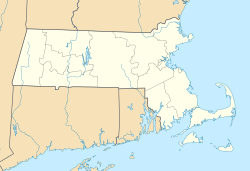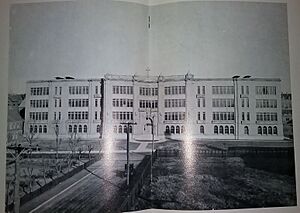St. Anne Shrine of Fall River facts for kids
Quick facts for kids |
|
|
St. Anne Shrine
|
|

(2021)
|
|
| Location | Fall River, Massachusetts |
|---|---|
| Built | 1891 |
| Architect | Napoléon Bourassa Louis G. Destremps |
| Architectural style | Romanesque |
| MPS | Fall River MRA |
| NRHP reference No. | 83000719 |
| Added to NRHP | February 16, 1983 |
St. Anne Shrine is a very old and important building in Fall River, Massachusetts. It is located where South Main and Middle streets meet. For many years, until 2018, it was a Catholic church for the local community.
The St. Anne Shrine is more than just a church. It also has a building that used to be a monastery for the Dominican Order, a group of priests and brothers. There was also a school called the Dominican Academy, built in 1894. The main, large part of the church, called the upper church, was officially opened on July 4, 1906. It closed on November 25, 2018. However, a smaller part of the church, called the Lower Crypt Church shrine, reopened on July 4, 2019. The upper part of the church is still closed as it is being fixed up and made new again.
The church was designed by a Canadian architect named Napoléon Bourassa. He used a style called Romanesque Revival. Building started in 1891. Another architect from Fall River, Louis G. Destremps, helped manage the construction. Work on the upper church began on July 17, 1902. The building is made from beautiful blue marble from Proctor, Vermont. It is very large, measuring 277 feet long and 122 feet wide. Its tall steeples reach 160 feet into the sky. The outside of the church was finished in June 1904. The entire new church was officially opened on July 4, 1906.
Because of its history and special design, the St. Anne Shrine was added to the National Register of Historic Places in 1983. This means it is recognized as an important historical site.
Contents
The Dominican Order's Role
The Dominican Order, a group of Catholic priests and brothers, was in charge of the church and shrine from 1891 until 1978. After that, it became part of the Diocese of Fall River again. The Dominicans worked hard to make the shrine a special place for people to visit, pray, and go on pilgrimages.
One very important person was Father Vincent Marchildon. He was the first official director of the shrine. Father Marchildon spent 60 years of his life helping at Saint Anne's. He organized special trips, prayer events called novenas, and processions to honor Saint Anne. Father Marchildon and two other Dominican founders are buried in the lower church crypt.
Stories of Healings
Since the church first started, people have connected Saint Anne with "miraculous" healings that cannot be easily explained. The first pastor, Monsignor Adrien de Montaubricq, was hurt when a stage fell during a ceremony. He promised that if he got better, he would dedicate the church to Saint Anne. He did get better, and he kept his promise.
Because of this, a special nine-day prayer event, called a Novena to Saint Anne, was held every year before her Feast Day on July 26.
When the "new" church was built, the Dominican Friars hoped it would become a famous shrine. They wanted it to be like the Shrine of Sainte-Anne-de-Beaupré in Quebec, Canada. By the mid-1920s, many people started visiting the shrine. An official director was then named to manage it every day. People came from all over the area to hear sermons, attend healing services, and pray to Saint Anne. They also came to see special items called first-class relics of Saint Anne.
During healing services, people would come with canes, crutches, or wheelchairs, hoping to be helped by Saint Anne. Father Marchildon would pray over them and anoint them with oil. He would often tell them to pray a nine-day novena to Saint Anne at the same time each day. He said that on the ninth day, they would be healed. Many people returned to the shrine later, saying they were "healed." They would leave their crutches, canes, and wheelchairs as a thank you to Saint Anne. These items are still on display at the shrine today. They remind visitors of the stories of healing.
The Catholic Church never officially checked or approved these "healings." However, the Dominican Friars, who managed the shrine for over 90 years, thought it was important to write down these stories. These documents are now kept in the Archives of the Dominican Order in Montreal, Canada.
Church Closure
The main upper church had to close in May 2015. This happened after a large piece of plaster fell from a wall during a church service. After that, weekend services were held in the smaller lower crypt church. On October 15, 2018, Bishop Edgar da Cunha announced that St. Anne's would stop being a parish church. This official closure happened on November 25, 2018.
Reopening and Restoration
A group called the Saint Anne's Shrine Preservation Society is working to save and restore the church. This group is a registered non-profit organization. They made an agreement with the Diocese of Fall River and signed a ten-year lease for the property on July 1, 2019.
The society is actively raising money to fix the building. They want to repair damage from years of not being cared for. Over the next few years, they plan to restore the building. Their goal is to make it a shrine and a place for prayer and study. The lower church shrine reopened on July 4, 2019. However, the main church is still very damaged and is closed while restoration work continues.
On July 26, 2019, hundreds of people came to celebrate the Feast of Saint Anne. Bishop Edgar da Cunha led the service in the church's lower shrine. This was the first Mass held there since the closure. The Preservation Society is working hard to open the upper part of the church by 2029.
The lower shrine is the largest indoor votive candle shrine in Southern New England. It can hold over 3,000 wax votive candles. These candles are placed in different small chapels and prayer areas around the shrine.
The School
A school connected to St. Anne's opened in the 1880s. The first classes were held in the church basement. When the church opened a new school building in 1925, it had 1,559 students. By 2007, it was the largest Catholic elementary school in Fall River.
In 2001, there were 432 students. At one point in the 2000s, the school added a chapel on the first floor. The school spent $500,000 on new windows in 2001. Renovations to the cafeteria and gymnasium, and a new playground, were part of updates in 2005-2006.
The school closed at the end of the 2006–2007 school year. It had 206 students at that time, with 22 students graduating. About 20 of the students who were not graduating transferred to other Catholic schools in Fall River.
The school building has since been taken down. A medical building, run by Steward Health Care, now stands in its place.
Organs
The St. Anne Shrine has several organs, which are large musical instruments.
Casavant Organ, Opus 2793
The upper church has a very large Casavant Freres organ. It was built in 1964 and is known as Opus 2793. This organ has three keyboards for playing and a pedalboard for the feet. It has 84 ranks, which means groups of pipes, and a total of 4,518 pipes. These pipes range in length from 7 inches to over 32 feet! The organ was officially presented on October 12, 1964. A famous blind French organist and composer named Jean Langlais played it. This instrument was featured in a convention for the Organ Historical Society in 2005.
Aeolian-Skinner Organ Co., Opus 1133, 1947
The lower church has a smaller Aeolian-Skinner Organ. It was built in 1947. This organ has two keyboards. It has not been used since the early 2000s. There is a hope that this organ might be fixed during the ongoing restoration work.
Allen Organ Co. Protégé Series
The instrument currently used for services and celebrations in the lower church is a digital organ. It is an Allen Protégé digital organ. This organ has two keyboards. It provides good sound quality for worship in the shrine.
See also
- National Register of Historic Places listings in Fall River, Massachusetts
- Notre Dame de Lourdes Church (Fall River, Massachusetts)




